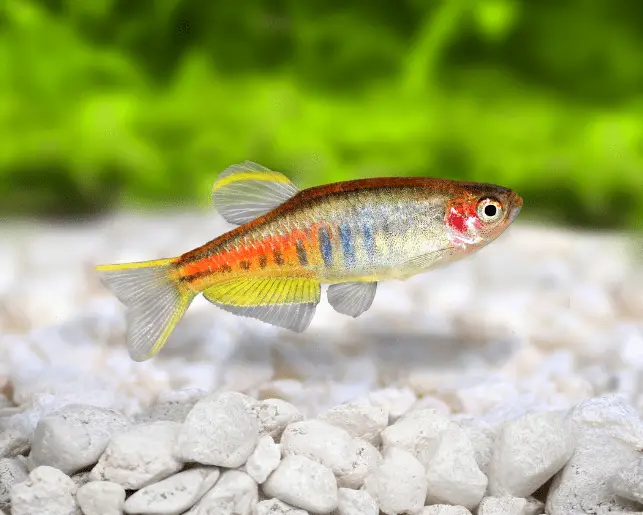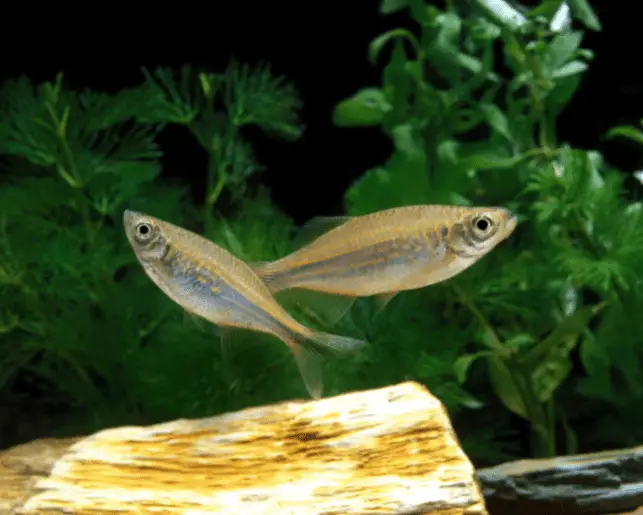Danios are a small, freshwater species of fish known for being lithe, easygoing, and friendly. However, they can jump to heights fairly impressive for a fish of their size.
Danios can jump anywhere as high as 20cm (8”) to 30cm (12”) and have been spotted jumping even higher than this on occasion. However, by keeping conditions stable and the tank closed, you can negate the issues with these leaping fish as much as possible.
In this article, I’ll cover more about the jumping behaviour of danios. I’ll explain why fish jump, if danios will jump out of their tanks, and what you can do to help prevent this.
Why Do Fish Jump?
Fish jump for a variety of reasons, including water conditions, natural inhibitions, or because they’re influenced by the behaviour of other fish. If you find that your danios or other fish are jumping out of their tank, it may be due to any of these factors.
Water Conditions.
If you suspect that the water in your danios’ tank has an issue, you can always do a partial water change. There are many instances where you would benefit from replacing up to a third of the water in your tank. This is also a good supporting solution and can be used alongside a number of the other below methods:
- Ammonia levels: If fish have died recently, or there’s a surplus of excess food floating around the tank, an ammonia spike may occur. This is when the amount of ammonia in the water exceeds the habitable amount. To reduce ammonia levels, remove any unnecessary organic matter, including dead fish, dead plants, food, and visible waste.
- Temperature: Fish can only survive comfortably in certain temperature ranges. Most common danio breeds can survive in a variety of temperatures, but the tank is the most homely around 18 – 25°C (64 – 77°F). If your tank is too hot or too cold, your fish will likely try to escape.
- pH levels: Danios thrive best in 6.5-7.0 pH levels. Use a pH testing kit to determine the acidity of your tank, and use an adjustment kit to increase or decrease the level accordingly.
- Water quality: The water in your tank should be relatively clear and free of debris. Danios tend to be more easily accustomed to water quality than other, more picky fish. Make sure substrate, gravel, food, and waste are not obstructing the view of your tank, and your danios should have no issues.

The Behaviour of Other Fish in the Tank.
If your danios are too crowded, or if the other fish are aggressive, it may cause undue stress and disease, ultimately leading to them trying to jump out. Keep a close eye on your other fish, and make sure your danios have enough space.
Food Levels.
The food in the tank should be a reasonable amount. If your fish aren’t being fed enough, they may try to escape. In addition, if you are feeding your danios quite often, monitor the amount of food being eaten. You may find that your fish are leaving food uneaten, which may make conditions undesirable.
The Fish’s Natural Instincts.
Some fish are, unfortunately, more likely to jump than others. Among these are danios, who may jump out of the water even with perfect living conditions. This does not indicate that a fish has emotions complex enough to determine if and why it should jump.
Will Danios Jump Out of the Tank?
Danios will likely jump out of the tank. They’re one of the more active and jumpy fish breeds, and many owners report their danios jumping out of the tank. They will jump less often if the conditions are good, but they still have an innate necessity to jump out of water.
Compatible Environments for Danios.
If your danios are surrounded by similarly active fish and a tank with many adornments, they may feel less stressed and less likely to jump. Use your own judgement to determine if your fish seem like they are eating and swimming normally.
Can Danios Live in an Open Tank?
Danios cannot live in an open tank because they will jump out. The tank lid must be tightly fastened at all times to prevent danios from escaping. Danios tend to swim at the surface or in the middle of the tank, fairly close to the top of the water, and are prone to dangers if the tank isn’t lidded.
Do Giant Danios Jump?
Giant danios jump out of the water just like average danio breeds. To help avoid this, make sure that your tank lid is fitted securely. Also, ensure your tank is large enough to accommodate the larger size of giant danios to diminish the chance of them jumping out.
The Difference Between Giant Danios and Other Breeds.

Giant danios are very similar to other, smaller danios, but they require a few extra bits of care. This is due mainly to their size and body composition, as detailed below.
Tank Size.
Given the size of giant danios, which can be up to three times the size of common zebra or leopard types, you need an appropriately sized enclosure. Aim for at least 208 litres (55 gallons) of water, emphasising a large length-to-height ratio.
Oxygen and Filter Needs.
Giant danios consume more oxygen than smaller fish, so make sure you have a large capacity filter to circulate plenty of oxygen. Danios can live in various water currents, but try to keep your giant danios in still water, as they’re used to quiet lakes and ponds.
Type of Lid.
Because of their increased size, giant danios have more mass and can easily jump to dislodge or move a lid that is not properly secured. When housing giant danios, make sure the cover is sturdy, hefty, and unable to be easily removed.
Conclusion.
Like many other fish, danios leap from the water quite often. Anecdotal experience from fish owners reflects a jump height from 20cm (8”) to 30cm (12”) consistently. However, by keeping your danios happy and healthy, you can reduce the risk of unsafe jumping. Keeping a lid on your tank is the best way to ensure your danios remain unharmed by their own erratic behaviour.
Related Articles:
How many danios can you put in a tank?
All you need to know about Zebra Danios.

